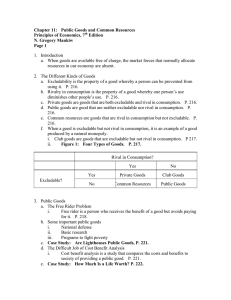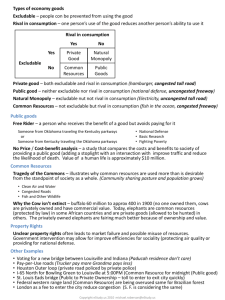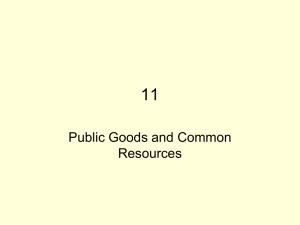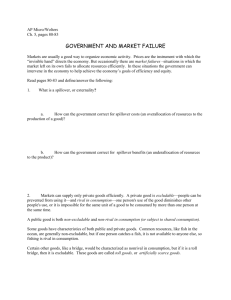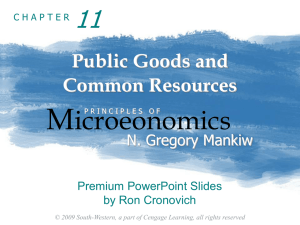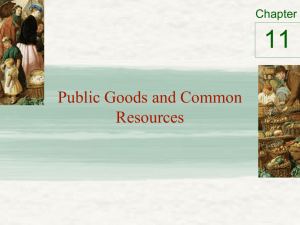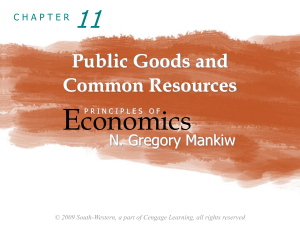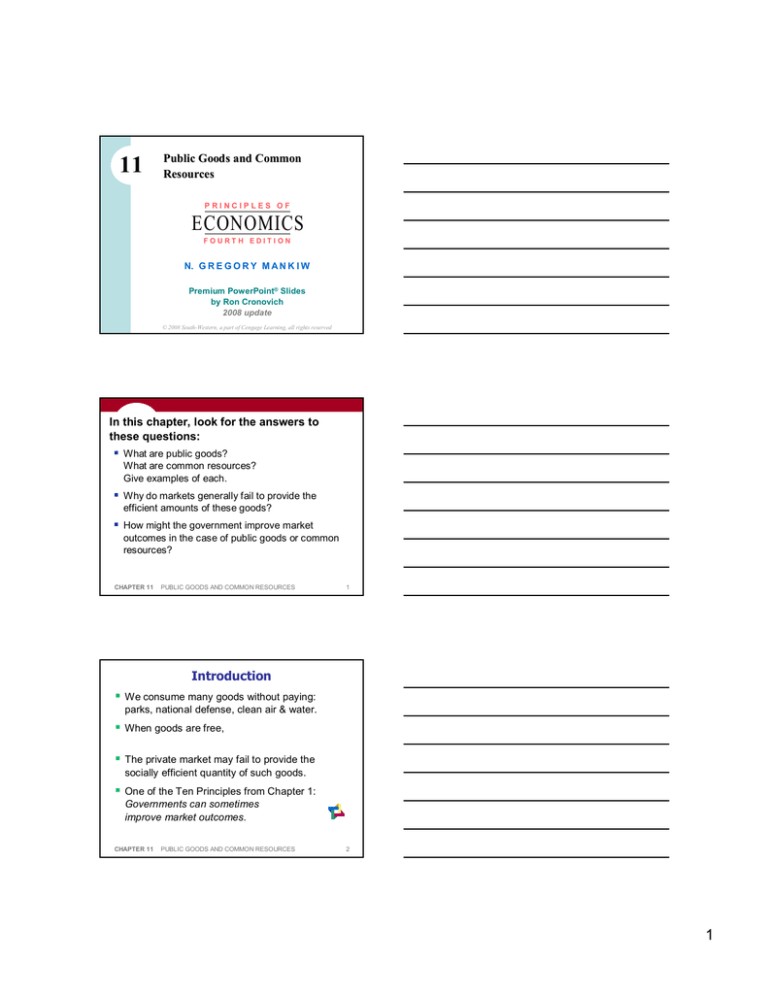
11
Public Goods and Common
Resources
PRINCIPLES OF
ECONOMICS
FOURTH EDITION
N. G R E G O R Y M A N K I W
Premium PowerPoint® Slides
by Ron Cronovich
2008 update
© 2008 South-Western, a part of Cengage Learning, all rights reserved
In this chapter, look for the answers to
these questions:
§ What are public goods?
What are common resources?
Give examples of each.
§ Why do markets generally fail to provide the
efficient amounts of these goods?
§ How might the government improve market
outcomes in the case of public goods or common
resources?
CHAPTER 11
PUBLIC GOODS AND COMMON RESOURCES
1
Introduction
§ We consume many goods without paying:
parks, national defense, clean air & water.
§ When goods are free,
§ The private market may fail to provide the
socially efficient quantity of such goods.
§ One of the Ten Principles from Chapter 1:
Governments can sometimes
improve market outcomes.
CHAPTER 11
PUBLIC GOODS AND COMMON RESOURCES
2
1
Important Characteristics of Goods
§ A good is excludable if
•
•
excludable:
not excludable:
§ A good is rival in consumption if
•
•
rival:
not rival:
CHAPTER 11
PUBLIC GOODS AND COMMON RESOURCES
3
The Different Kinds of Goods
Private goods:
example:
Public goods:
example:
Common resources:
example:
Natural monopolies:
example:
CHAPTER 11
PUBLIC GOODS AND COMMON RESOURCES
4
A C T I V E L E A R N I N G 1:
Categorizing roads
§ A road is which of the four kinds of goods?
§ Hint: The answer depends on whether the road
is congested or not, and whether it’s a toll road
or not. Consider the different cases.
5
2
The Different Kinds of Goods
§ This chapter focuses on public goods and
common resources.
§ For both,
§ So, private decisions about consumption and
production
§ Public policy can potentially raise economic
well-being.
CHAPTER 11
PUBLIC GOODS AND COMMON RESOURCES
7
Public Goods
§ Public goods are difficult for private markets to
provide because of the free-rider problem.
§ Free rider:
•
If good is not excludable, people have incentive
to be free riders, because firms cannot prevent
non-payers from consuming the good.
§ Result: The good is not produced,
CHAPTER 11
PUBLIC GOODS AND COMMON RESOURCES
8
Public Goods
§ If the benefit of a public good exceeds the cost of
providing it, govt should provide the good and pay
for it with a tax on people who benefit.
§ Problem: Measuring the benefit is usually difficult.
§ Cost-benefit analysis:
§ Cost-benefit analyses are imprecise, so the
efficient provision of public goods is more difficult
than that of private goods.
CHAPTER 11
PUBLIC GOODS AND COMMON RESOURCES
9
3
Some Important Public Goods
CHAPTER 11
PUBLIC GOODS AND COMMON RESOURCES
10
Common Resources
§ Like public goods,
•
•
•
cannot prevent free riders from using
little incentive for firms to provide
role for govt: seeing that they are provided
§ Additional problem with common resources:
•
role for govt: ensuring they are not overused
CHAPTER 11
PUBLIC GOODS AND COMMON RESOURCES
11
The Tragedy of the Commons
§ A parable that illustrates why common resources
get used more than is socially desirable.
§ Setting: a medieval town, where sheep graze on
common land.
§ As the population grows, the # of sheep grows.
§ The amount of land is fixed,
the grass begins to disappear from overgrazing.
CHAPTER 11
PUBLIC GOODS AND COMMON RESOURCES
12
4
The Tragedy of the Commons
§ The tragedy is due to an externality:
Allowing one’s flock to graze on the common land
reduces its quality for other families.
§
CHAPTER 11
PUBLIC GOODS AND COMMON RESOURCES
13
A C T I V E L E A R N I N G 2:
Policy options for common resources
§ What could the townspeople
(or their government)
have done to prevent the tragedy?
§ Try to think of two or three options.
14
Policy Options to Prevent
Overconsumption of Common Resources
CHAPTER 11
PUBLIC GOODS AND COMMON RESOURCES
16
5
Some Important Common Resources
CHAPTER 11
PUBLIC GOODS AND COMMON RESOURCES
17
CASE STUDY: “You’ve Got Spam!”
§ Spam e-mail is a service some firms use to
advertise their products.
§ Spam is
§ Spam is rival:
§ Thus,
§ Like most common resources,
CHAPTER 11
PUBLIC GOODS AND COMMON RESOURCES
18
CONCLUSION
§
§ These problems arise because
•
•
Nobody owns the air, so no one can charge
polluters. Result: too much pollution.
Nobody can charge people who benefit from
national defense. Result: too little defense.
§ The govt can potentially solve these problems
with various policy options.
CHAPTER 11
PUBLIC GOODS AND COMMON RESOURCES
19
6

